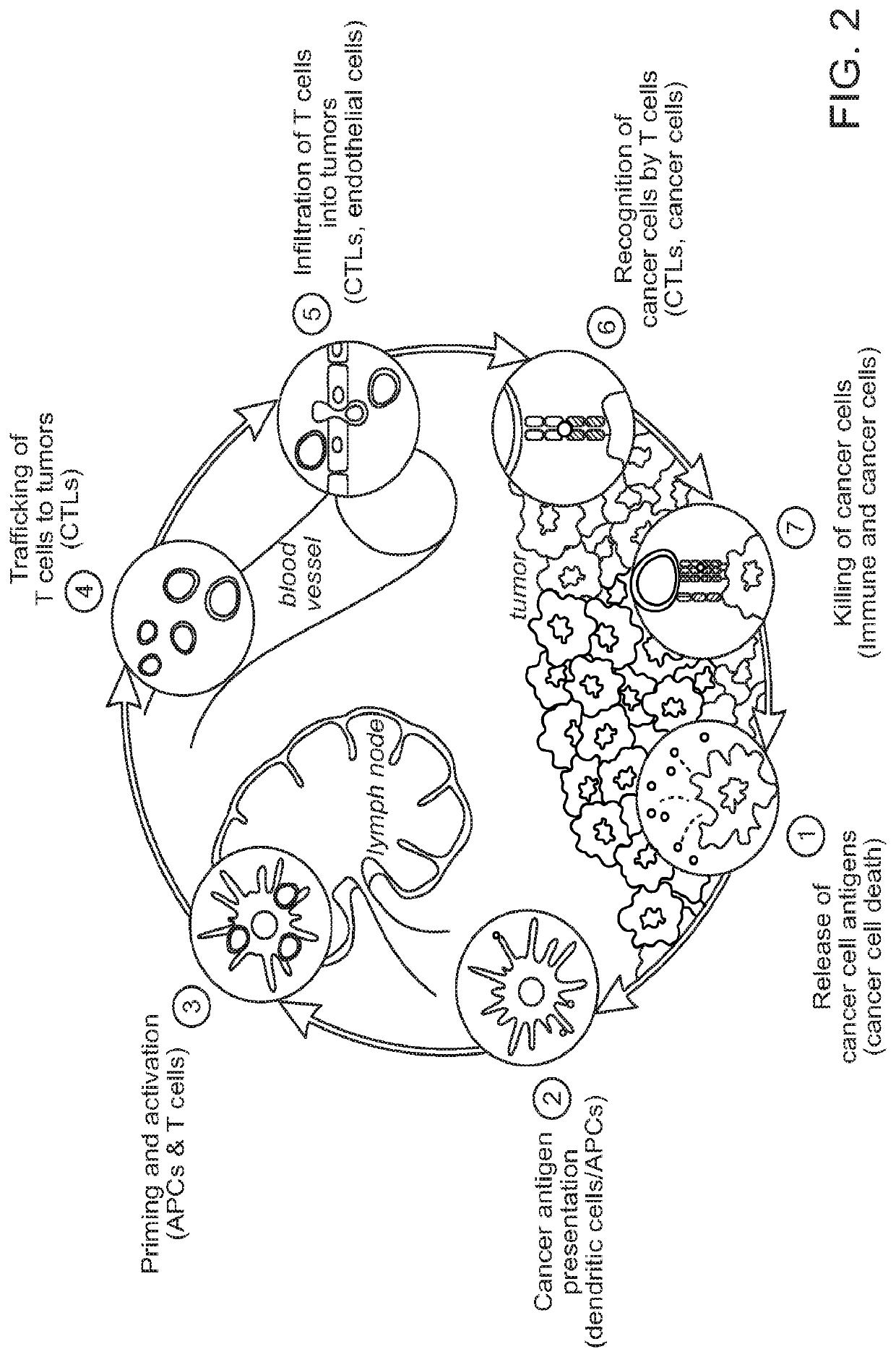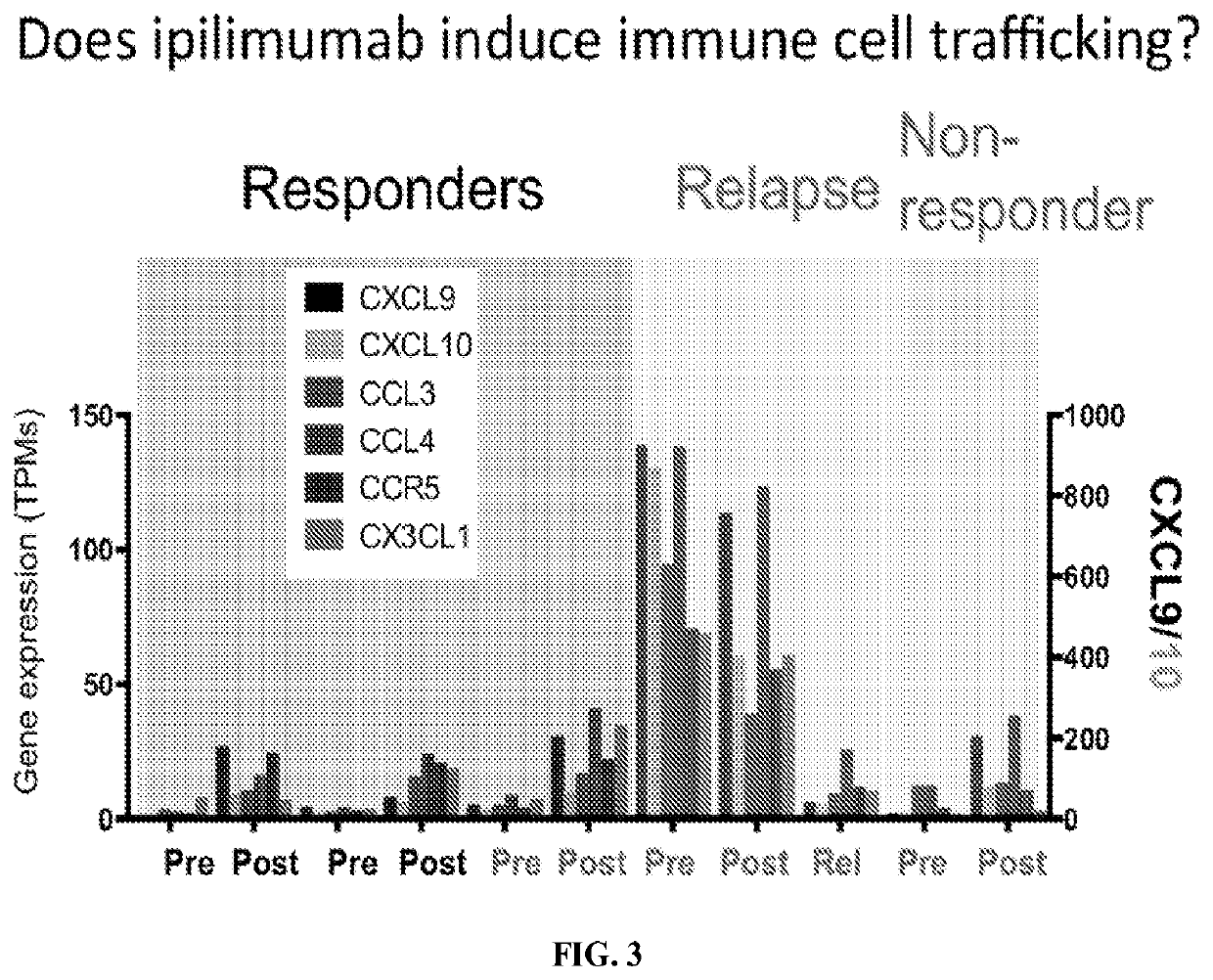Compositions and methods for identifying and treating resistance to ctla4 antagonists in leukemia
a technology of ctla4 and resistance, applied in the field of compositions and methods for identifying and treating resistance to ctla4 antagonists in neoplasia, can solve the problems that many patients with leukemia do not respond to ipilimumab treatment, and achieve the effects of reducing severity and/or frequency of symptoms, eliminating symptoms, and facilitating improvement or remediation of damag
- Summary
- Abstract
- Description
- Claims
- Application Information
AI Technical Summary
Benefits of technology
Problems solved by technology
Method used
Image
Examples
example 1
ckade After Allogenic Transplantation
[0206]CTLA4 inhibition may re-awaken a dormant Graft-versus-leukemia (GVL) effect with less toxicity than donor lymphocyte infusions (DLI). To assess whether CTLA4 blockade is safe and / or effective after allogenic transplantation, 28 patients with relapsed hematologic cancer were treated with Ipilimumab after allogenic hematopoietic stem cell transplantation (HSCT) at either 3 mg / kg (n=6) or 10 mg / kg (n=22). No responses were observed at the low-dose; however, 59% of the high-dose patients had tumor reduction (including durable complete remissions) as shown in FIG. 1, which shows photographic images of a leukemia cutis associated cutaneous lesion before (top left panel) and after (top right panel) treatment with a single dose of Ipilimumab, as well as histologically stained tissue sections of the cutaneous lesion before (bottom left panel) and after (bottom right panel) treatment.
[0207]FIG. 2 depicts a schematic of the Cancer-Immunity Cycle, whic...
example 2
pilimumab in Immune Cell Trafficking
[0209]As shown in FIG. 3, there was an increase in expression of genes responsible for immune cell trafficking after Ipilimumab treatment in both responding and nonresponding tumors as indicated by the difference in expression levels pre- and post-treatment. Expression levels were tested for the following genes: C-X-C Motif Chemokine Ligand 9 (CXCL9; shown in black), C-X-C Motif Chemokine Ligand 10 (CXCL10; shown in orange), C-C Motif Chemokine Ligand 3 (CCL3; shown in maroon), C-C Motif Chemokine Ligand 4 (CCL4; shown in purple), C-C Motif Chemokine Receptor 5 (CCR5; shown in blue), and C-X3-C Motif Chemokine Ligand 1 (CX3CL1; shown in green). As can be seen in the bar graph, pre-Ipilimumab tumor in the relapsing patient has a very high ‘inflamed’ baseline of chemokines that is downregulated in the post-Ipilimumab relapsed tumor.
example 3
of Leukemic Bed Infiltration
[0210]As shown in FIG. 4, there was an increase in genes responsible for immune cell trafficking through the vascular endothelium after Ipilimumab treatment in both responding and nonresponding tumors. Expression levels were tested for the following genes: Intercellular Adhesion Molecule 1 (ICAM1; shown in black) and Vascular Cell Adhesion Molecule 1 (VCAM1; shown in gray). As can be seen in FIG. 4, pre-Ipilimumab tumor in the relapsing patient has a very high ‘inflamed’ baseline of chemokines that is downregulated in the post-Ipilimumab relapsed tumor.
[0211]FIG. 5 assess the specific immune cell sub-populations corresponding to T cells, B cells, and Macrophages, respectively. After treatment with Ipilimumab, CD8A expression is increased in T cells, CD20 and CD138 expression is increased in B cells and plasma cells, respectively, and the expression of MRC1 and CD163 and Chemerin is increased in macrophages. However, in the non-responding patient increased...
PUM
| Property | Measurement | Unit |
|---|---|---|
| Ka | aaaaa | aaaaa |
| dissociation constant | aaaaa | aaaaa |
| temperatures | aaaaa | aaaaa |
Abstract
Description
Claims
Application Information
 Login to View More
Login to View More - R&D
- Intellectual Property
- Life Sciences
- Materials
- Tech Scout
- Unparalleled Data Quality
- Higher Quality Content
- 60% Fewer Hallucinations
Browse by: Latest US Patents, China's latest patents, Technical Efficacy Thesaurus, Application Domain, Technology Topic, Popular Technical Reports.
© 2025 PatSnap. All rights reserved.Legal|Privacy policy|Modern Slavery Act Transparency Statement|Sitemap|About US| Contact US: help@patsnap.com



